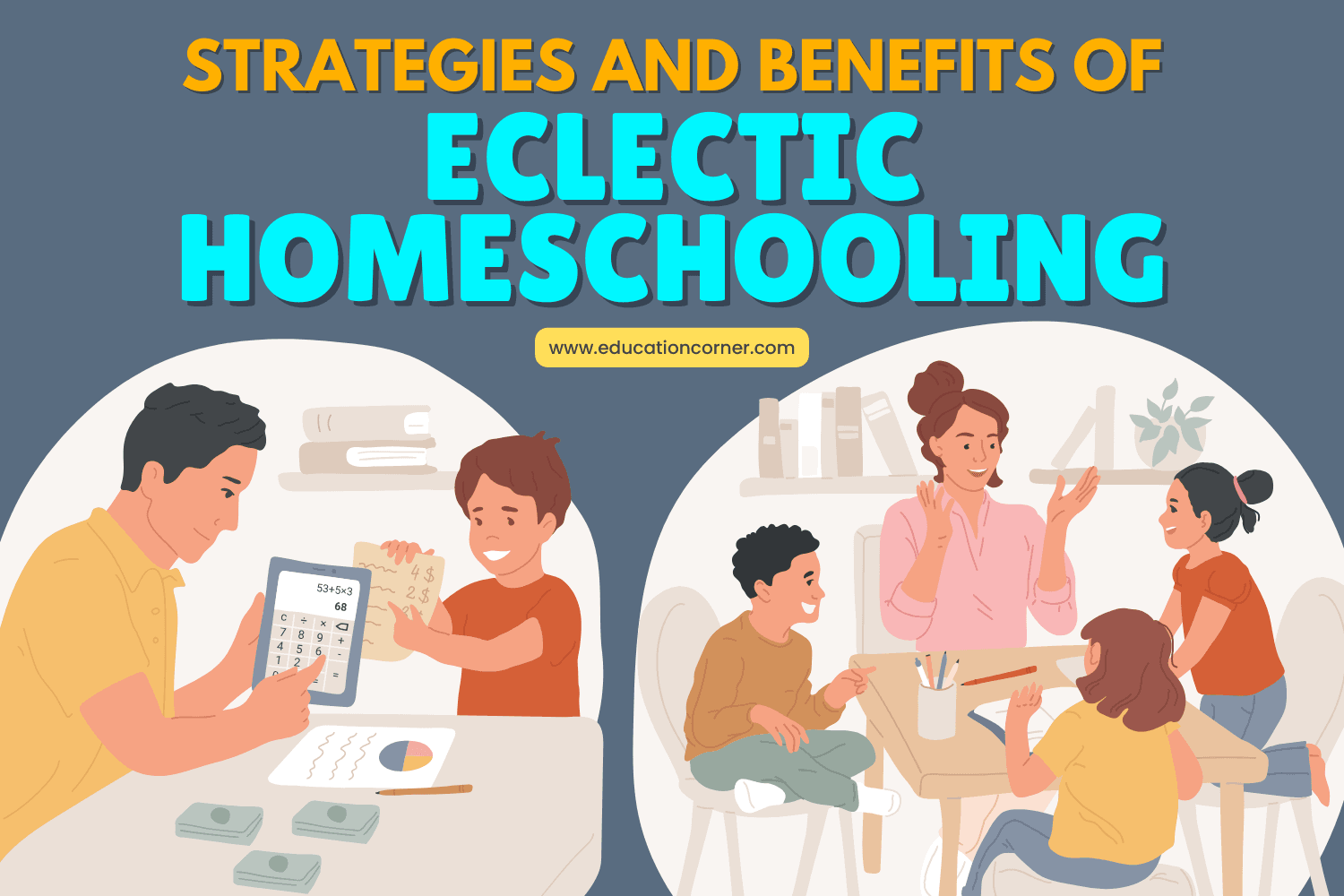“Eclectic Homeschooling” is an approach to homeschooling in which parents pick and choose the best parts of several different homeschooling resources. As such, it’s not exactly a set homeschooling philosophy (like the Classical or Charlotte Mason philosophies), because it will be completely different for every family who implements it.
Eclectic homeschooling has become very popular because it allows parents to design a schedule with their children’s unique personalities in mind. You know best what your kids like and what they find interesting.
You probably also feel that some topics are particularly important or engaging, and eclectic homeschooling gives you a great avenue to focus on those topics.
As you design your schedule and curriculum, you can adopt the methods that fit well with your family’s style, and leave out anything that isn’t such a great fit. It’s a highly personalized, customized approach to homeschooling.
To some homeschoolers, however, creating an eclectic curriculum sounds intimidating.
Here are a few basic strategies to get you on the right track:
Start with a basic framework
You don’t need to design a whole curriculum out of nothing. Sometimes eclectic homeschooling simply means choosing certain parts of a curriculum and leaving out the rest.
Find a guidebook or program that you find appealing and helpful, and use the parts of it that resonate with you and your style. If it offers suggestions that you don’t agree with, or which just don’t fit with your children’s learning style, leave them out. Simple as that.
Use textbooks, but don’t be bound to them
Just like your overall framework, you can use textbooks and programs to teach certain subjects. Textbooks can be valuable tools, especially if you’re not a bona fide expert in that subject.
Unlike traditional schools, however, eclectic homeschoolers can skip over activities that don’t fit well with their style, and can switch to different textbooks whenever they please.
Join a homeschooling “co-op”
Homeschooling coops are informal collaborations between several homeschooling families. Typically, parents take turns teaching various classes (depending on the parents’ strengths and expertise), and may even travel to community centers, libraries, or museums together for enrichment classes. These coops are a great way to pool your community’s knowledge and talents, and they offer your children valuable socialization as well.
Design lessons in response to your children’s needs
As you go along, it will become clear what areas your kids need a little extra help in. Knowing your children best, you can design activities and lessons which will help compensate for these relative weaknesses and ultimately overcome them.
Be mindful of their learning styles as you design these lessons. If your child struggles in a subject, you may want to include occasional breaks in the lesson, or present it in an entertaining, playful way.
Give children space to learn naturally
Lessons needn’t be formal or strict. Reading, for example, could be as simple as a trip to the library, where your kids can choose whatever book interests them. Or you could read them stories out loud before bedtime, to strengthen their listening comprehension.
Pay attention to your children’s interests
The best part about eclectic homeschooling is getting to design a curriculum based on your child’s unique personality, something that public schools couldn’t possibly accomplish. What is your child passionate about? Or at least interested in?
Design lessons which build on and encourage those interests, to further bring out your children’s innate strengths and talents.
Is Eclectic Homeschooling the Same as Unschooling?
Not exactly. The two approaches certainly share a great deal in common, but they’re not quite the same thing.
Unschooling is often called “child-led learning.” It’s a philosophy in which the child chooses what subjects to study, and at what pace. The parents act less as teachers and more as facilitators, providing the child with the materials, resources, and opportunities necessary to pursue his interests as independently as possible.
Eclectic homeschooling offers parents a great deal of flexibility to respond to their children’s interests and design lesson plans accordingly. However, parents typically choose what topics are covered, and may even provide a rough schedule to follow.
In other words, eclectic homeschooling occupies the middle ground between the rigidly structured curriculum of traditional schooling, and the free, structureless approach of unschooling.
The Pros of Eclectic Homeschooling
Flexibility
Children’s interests evolve and change, sometimes at a staggering rate. Eclectic homeschooling gives parents the flexibility to adapt to those changes as they occur. There’s no need to complete a pre-packaged curriculum if it no longer suits your needs, and you can change strategies and materials at any time.
Customizable
Rather than forcing a child into a one-size-fits-all approach to education, you can design your lesson plan according to your child’s unique personality and learning style. You can even design different teaching plans for different children.
Inexpensive
Picking and choosing your own resources can cost a lot less money than paying for an all-inclusive pre-packaged curriculum.
Parents help choose the course of study
In contrast to Unschooling, in which the child takes full control of their education, Eclectic Homeschooling gives parents a measure of control in deciding a course of study.
The Cons of Eclectic Homeschooling
More prep time
Designing your own, customized curriculum takes much more time and preparation than just using a set, pre-packaged curriculum.
You’re completely responsible
Choosing what to teach and how to teach it requires a fair amount of research. Since the plan you’re creating is unique and customized, you’re completely responsible for its outcome.
Every child is different
Eclectic homeschooling seeks to create a course of study specially adapted to your child’s needs. As such, you need to be constantly alert and attentive to your child’s evolving interests, and be ready to change directions whenever necessary.

